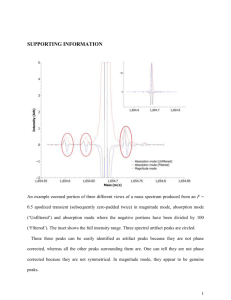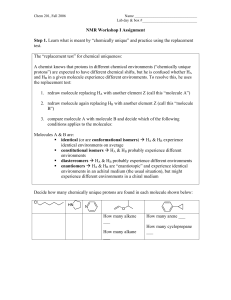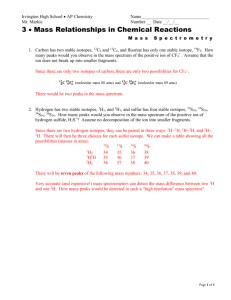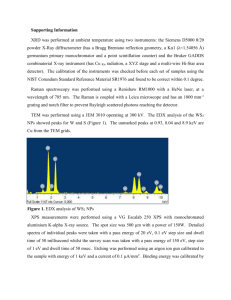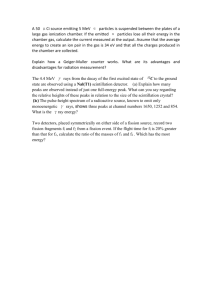Reading NMR Spectra
advertisement
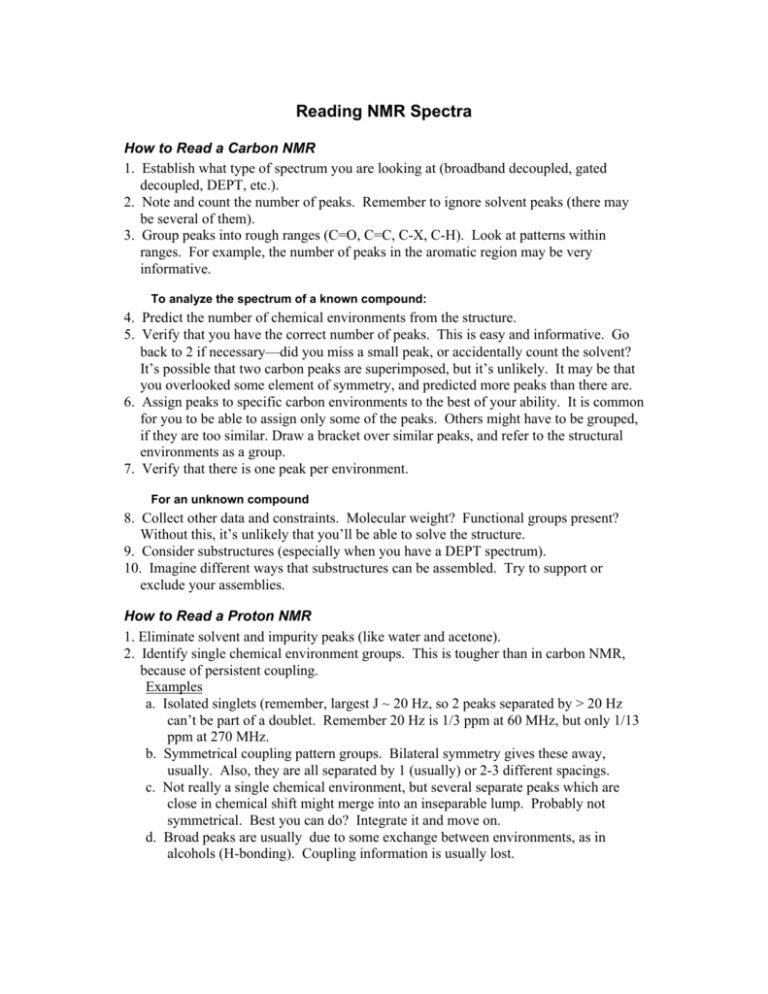
Reading NMR Spectra How to Read a Carbon NMR 1. Establish what type of spectrum you are looking at (broadband decoupled, gated decoupled, DEPT, etc.). 2. Note and count the number of peaks. Remember to ignore solvent peaks (there may be several of them). 3. Group peaks into rough ranges (C=O, C=C, C-X, C-H). Look at patterns within ranges. For example, the number of peaks in the aromatic region may be very informative. To analyze the spectrum of a known compound: 4. Predict the number of chemical environments from the structure. 5. Verify that you have the correct number of peaks. This is easy and informative. Go back to 2 if necessary—did you miss a small peak, or accidentally count the solvent? It’s possible that two carbon peaks are superimposed, but it’s unlikely. It may be that you overlooked some element of symmetry, and predicted more peaks than there are. 6. Assign peaks to specific carbon environments to the best of your ability. It is common for you to be able to assign only some of the peaks. Others might have to be grouped, if they are too similar. Draw a bracket over similar peaks, and refer to the structural environments as a group. 7. Verify that there is one peak per environment. For an unknown compound 8. Collect other data and constraints. Molecular weight? Functional groups present? Without this, it’s unlikely that you’ll be able to solve the structure. 9. Consider substructures (especially when you have a DEPT spectrum). 10. Imagine different ways that substructures can be assembled. Try to support or exclude your assemblies. How to Read a Proton NMR 1. Eliminate solvent and impurity peaks (like water and acetone). 2. Identify single chemical environment groups. This is tougher than in carbon NMR, because of persistent coupling. Examples a. Isolated singlets (remember, largest J ~ 20 Hz, so 2 peaks separated by > 20 Hz can’t be part of a doublet. Remember 20 Hz is 1/3 ppm at 60 MHz, but only 1/13 ppm at 270 MHz. b. Symmetrical coupling pattern groups. Bilateral symmetry gives these away, usually. Also, they are all separated by 1 (usually) or 2-3 different spacings. c. Not really a single chemical environment, but several separate peaks which are close in chemical shift might merge into an inseparable lump. Probably not symmetrical. Best you can do? Integrate it and move on. d. Broad peaks are usually due to some exchange between environments, as in alcohols (H-bonding). Coupling information is usually lost. 3. Collect data. Maybe annotate spectrum (see attached), or do a table. Information for each ‘peak’: δ, multiplicity, J, integral. Reporting format could look like: δ=3.3, t, 7.5 Hz, 2H. Remember what the pieces of information tell you (see figure below). Many students confuse the information from integrals with that from multiplicity. 4. Consider what Number of neighbors to one H environments might give in environment: multiplicity rise to the chemical shifts you observe. Don't X C CH3 H2 Chemical forget to consider all Number of H's in Environment-possibilities, instead of Chemical Shift this environment: stopping at the first one Integral δ on the chart. Also remember the additivity of substituent effects. 5. The integrals will give Quartet relative intensities. Try to find a solution which gives whole number J coupling constants J values for each are equal environment, and adds up to the total number of protons in the sample. Consider symmetry: a 2-proton signal is often due to a methylene group (-CH2-), but it may arise from two separate, but chemically identical hydrogens. 6. Think about what the multiplicity means—how many neighbors to the proton (remember the N+1 rule). Start dreaming up structural elements or substructures, although you should remember that you are guessing here. Try to decide what’s coupled to what, by matching coupling constants (J values) between two separate environments. Coupling is a two-way street--if you see one multiplet, there must be another somewhere! 7. When you have developed a structure, it is always worth predicting the spectrum of each proton, then checking against the actual spectrum to ensure that you have considered everything. Each proton, when checked, should give the right chemical shift and the right multiplicity.

